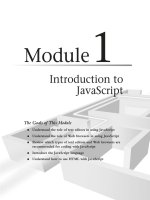Chapter 3 introduction to javascript
Bạn đang xem bản rút gọn của tài liệu. Xem và tải ngay bản đầy đủ của tài liệu tại đây (1.07 MB, 71 trang )
Chapter 3
Introduction to Javascript
Lectured by:
Nguyễn Hữu Hiếu
JavaScript
n
n
n
JavaScript is the programming language of HTML
and the Web.
Programming makes computers do what you want
them to do. JavaScript is easy to learn.
This tutorial will teach you JavaScript from basic to
advanced.
Trường Đại Học Bách Khoa TP.HCM
Khoa Khoa Học và Kỹ Thuật Máy Tính
© 2017
Lập Trình Web
2
Why Study JavaScript?
n
JavaScript is one of the 3 languages all web
developers must learn:
1.
2.
3.
n
HTML to define the content of web pages
CSS to specify the layout of web pages
JavaScript to program the behaviour of web
pages
This lecture is about JavaScript, and how
JavaScript works with HTML and CSS.
Trường Đại Học Bách Khoa TP.HCM
Khoa Khoa Học và Kỹ Thuật Máy Tính
© 2017
Lập Trình Web
3
JavaScript Introduction
n
n
JavaScript Can Change HTML Content
One of many HTML methods is getElementById().
This example uses the method to "find" an HTML
element (with id="demo"), and changes the
element content (innerHTML) to "Hello JavaScript”:
document.getElementById("demo").innerHTML
= "Hello JavaScript”;
Trường Đại Học Bách Khoa TP.HCM
Khoa Khoa Học và Kỹ Thuật Máy Tính
© 2017
Lập Trình Web
4
Example
<!DOCTYPE html>
<html>
<body>
What Can JavaScript Do?
JavaScript can change HTML content.
onclick="document.getElementById('demo').innerHTML =
'Hello JavaScript!'">
Click Me!
</button>
</body>
</html>
Trường Đại Học Bách Khoa TP.HCM
Khoa Khoa Học và Kỹ Thuật Máy Tính
© 2017
Lập Trình Web
5
JavaScript Can Change HTML Attributes
This example changes an HTML image, by changing the src attribute of an
<img> tag:
<!DOCTYPE html><html>
<body>
JavaScript Can Change Images
 height="180”>
height="180”>Click the light bulb to turn on/off the light.
<script>
function changeImage() {
var image = document.getElementById('myImage');
if (image.src.match("bulbon")) {
image.src = "pic_bulboff.gif"; } else {
image.src = "pic_bulbon.gif"; }
}
</script>
</body> </html>
Trường Đại Học Bách Khoa TP.HCM
Khoa Khoa Học và Kỹ Thuật Máy Tính
© 2017
Lập Trình Web
6
JavaScript Can Change HTML Styles (CSS)
<!DOCTYPE html>
<html>
<body>
What Can JavaScript Do?
JavaScript can change the style of an HTML element.
<script>
function myFunction() {
var x = document.getElementById("demo");
x.style.fontSize = "25px";
x.style.color = "red";
}
</script>
<button type="button" onclick="myFunction()">Click Me!</button>
</body>
</html>
Trường Đại Học Bách Khoa TP.HCM
Khoa Khoa Học và Kỹ Thuật Máy Tính
© 2017
Lập Trình Web
7
JavaScript Can Validate Data
n
JavaScript is often used to validate input
Trường Đại Học Bách Khoa TP.HCM
Khoa Khoa Học và Kỹ Thuật Máy Tính
© 2017
Lập Trình Web
8
Did You Know?
n
n
n
JavaScript and Java are completely different
languages, both in concept and design.
JavaScript was invented by Brendan Eich in 1995,
and became an ECMA standard in 1997.
ECMA-262 is the official name. ECMAScript 5
(JavaScript 1.8.5 - July 2010) is the current
standard
Trường Đại Học Bách Khoa TP.HCM
Khoa Khoa Học và Kỹ Thuật Máy Tính
© 2017
Lập Trình Web
9
JavaScript Where To
n
n
JavaScript can be placed in the <body> and the
<head> sections of an HTML page.
The <script> Tag In HTML, JavaScript code must
be inserted between <script> and </script> tag
<script>
document.getElementById("demo").innerHTML = "My First JavaScript”;
</script>
Trường Đại Học Bách Khoa TP.HCM
Khoa Khoa Học và Kỹ Thuật Máy Tính
© 2017
Lập Trình Web
10
JavaScript Functions and Events
n
n
n
A JavaScript function is a block of JavaScript code,
that can be executed when "asked" for.
For example, a function can be executed when an
event occurs, like when the user clicks a button.
You will learn much more about functions and
events in later chapters.
Trường Đại Học Bách Khoa TP.HCM
Khoa Khoa Học và Kỹ Thuật Máy Tính
© 2017
Lập Trình Web
11
JavaScript in <head> or <body>
n
n
n
You can place any number of scripts in an HTML
document.
Scripts can be placed in the <body>, or in the
<head> section of an HTML page, or in both.
Keeping all code in one place, is always a good
habit.
Trường Đại Học Bách Khoa TP.HCM
Khoa Khoa Học và Kỹ Thuật Máy Tính
© 2017
Lập Trình Web
12
JavaScript in <head>
n
n
In this example, a JavaScript function is placed in
the <head> section of an HTML page.
The function is invoked (called) when a button is
clicked:
Trường Đại Học Bách Khoa TP.HCM
Khoa Khoa Học và Kỹ Thuật Máy Tính
© 2017
Lập Trình Web
13
Example
<!DOCTYPE html>
<html>
<head>
<script>
function myFunction() {
document.getElementById("demo").innerHTML = "Paragraph
changed."; }
</script>
</head>
<body>
My Web Page
A Paragraph
<button type="button" onclick="myFunction()">Try it</button>
</body>
</html>
Trường Đại Học Bách Khoa TP.HCM
Khoa Khoa Học và Kỹ Thuật Máy Tính
© 2017
Lập Trình Web
14
JavaScript in <body>
n
n
In this example, a JavaScript function is placed in
the <body> section of an HTML page.
The function is invoked (called) when a button is
clicked:
Trường Đại Học Bách Khoa TP.HCM
Khoa Khoa Học và Kỹ Thuật Máy Tính
© 2017
Lập Trình Web
15
Example
<!DOCTYPE html>
<html>
<body>
My Web Page
A Paragraph
<button type="button" onclick="myFunction()">Try it</button>
<script>
function myFunction() {
document.getElementById("demo").innerHTML = "Paragraph
changed."; }
</script>
</body>
</html>
Trường Đại Học Bách Khoa TP.HCM
Khoa Khoa Học và Kỹ Thuật Máy Tính
© 2017
Lập Trình Web
16
External JavaScript
n
n
n
n
Scripts can also be placed in external files.
External scripts are practical when the same code is used in
many different web pages.
JavaScript files have the file extension .js.
To use an external script, put the name of the script file in
the src (source)
attribute of the <script> tag:
<!DOCTYPE html>
<html>
<body>
<script src="myScript.js"></script>
</body>
</html>
Trường Đại Học Bách Khoa TP.HCM
Khoa Khoa Học và Kỹ Thuật Máy Tính
© 2017
Lập Trình Web
17
External JavaScript
n
n
n
You can place an external script reference in <head> or
<body> as you like.
The script will behave as if it was located exactly where the
<script> tag is located.
External scripts cannot contain <script> tags.
Trường Đại Học Bách Khoa TP.HCM
Khoa Khoa Học và Kỹ Thuật Máy Tính
© 2017
Lập Trình Web
18
External JavaScript Advantages
n
Placing JavaScripts in external files has some
advantages:
n
n
n
It separates HTML and code
It makes HTML and JavaScript easier to read and
maintain
Cached JavaScript files can speed up page loads
Trường Đại Học Bách Khoa TP.HCM
Khoa Khoa Học và Kỹ Thuật Máy Tính
© 2017
Lập Trình Web
19
JavaScript Output
n
n
1.
2.
3.
4.
JavaScript does not have any built-in print or display
functions.
JavaScript Display Possibilities JavaScript can "display" data
in different ways:
Writing
Writing
Writing
Writing
into
into
into
into
an alert box, using window.alert().
the HTML output using document.write().
an HTML element, using innerHTML.
the browser console, using console.log().
Trường Đại Học Bách Khoa TP.HCM
Khoa Khoa Học và Kỹ Thuật Máy Tính
© 2017
Lập Trình Web
20
Using window.alert()
You can use an alert box to display:
<!DOCTYPE html>
<html>
<body>
My First Web Page
My first paragraph.
<script>
window.alert(5 + 6);
</script>
</body>
</html>
Trường Đại Học Bách Khoa TP.HCM
Khoa Khoa Học và Kỹ Thuật Máy Tính
© 2017
Lập Trình Web
21
Using document.write()
For testing purposes, it is convenient to use document.write():
<!DOCTYPE html>
<html>
<body>
My First Web Page
My first paragraph.
<script>
document.write(5 + 6);
</script>
</body>
</html>
Trường Đại Học Bách Khoa TP.HCM
Khoa Khoa Học và Kỹ Thuật Máy Tính
© 2017
Lập Trình Web
22
Using document.write()
Using document.write() after an HTML document is
fully loaded, will delete all existing HTML:
<!DOCTYPE html>
<html>
<body>
My First Web Page
My first paragraph.
<button onclick="document.write(5 + 6)">Try it</button>
</body>
</html>
Trường Đại Học Bách Khoa TP.HCM
Khoa Khoa Học và Kỹ Thuật Máy Tính
© 2017
Lập Trình Web
23
Using innerHTML
n
n
To access an HTML element, JavaScript can use
the document.getElementById(id) method.
The id attribute defines the HTML element. The
innerHTML property defines the HTML content:
Trường Đại Học Bách Khoa TP.HCM
Khoa Khoa Học và Kỹ Thuật Máy Tính
© 2017
Lập Trình Web
24
Example
<!DOCTYPE html>
<html>
<body>
My First Web Page
My First Paragraph
<script>
document.getElementById("demo").innerHTML = 5 + 6;
</script>
</body>
</html>
Trường Đại Học Bách Khoa TP.HCM
Khoa Khoa Học và Kỹ Thuật Máy Tính
© 2017
Lập Trình Web
25









